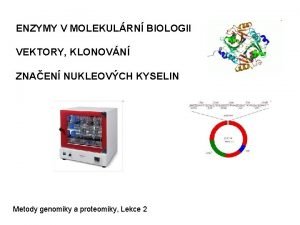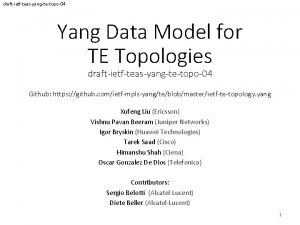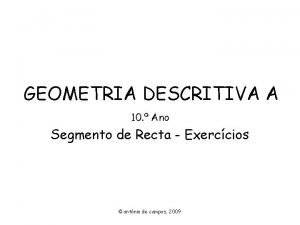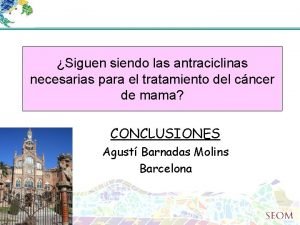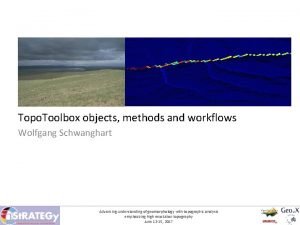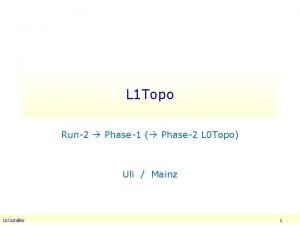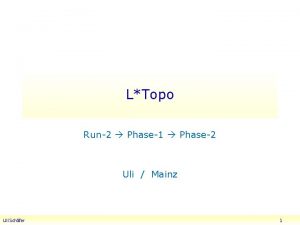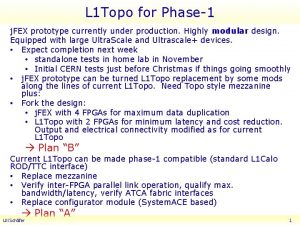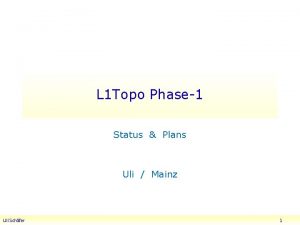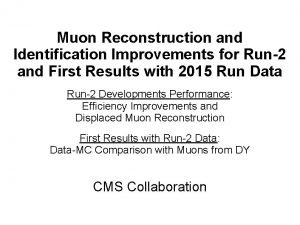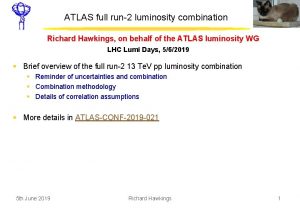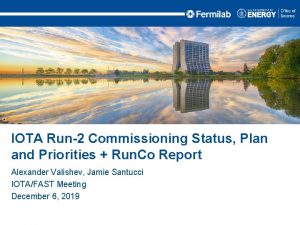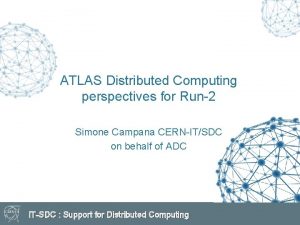L 1 Topo Run2 Phase1 Phase2 L 0















- Slides: 15

L 1 Topo Run-2 Phase-1 ( Phase-2 L 0 Topo) Uli / Mainz Uli Schäfer 1

L 1 Topo in its habitat Uli Schäfer 2

L 1 Topo / run 2 Uli Schäfer 3

L 1 Topo / Run-2 module control real-time path algorithms CTP readout / embedded ROD • five modules built for run 2 • two algorithmic processors • one DAQ/control FPGA • designed for phase-1/phase-2 compatibility • two modules deployed at point 1 • one module in test rig part of link speed tests (12. 8 Gb/s) Uli Schäfer 4

L 1 Topo unplugged Uli Schäfer 5

L 1 Topo floor plan / run-2 o/e Real-time path CMX/µ ATCA zone 3 Readout S-Link zone 2 mezzanine real-time path CTP (electrical) Uli Schäfer e/o 6

L 1 Topo phase 1 • Additional L 1 Topo production for phase 1 • 3 new modules were initially planned for phase 1 • 2 × topology • 1 × hit merger for L 1 Calo multiplicity triggers • Current L 1 Topo can act as a prototype: • Existent modules expected to match needs for Phase-1 • No changes to concept • Will need to run new PCB production anyway • Will allow for improvements / adaptation to phase-2 requirements • Expected to live in an ATCA water cooled “standard” shelf • Space • Power / cooling Uli Schäfer 7

L 1 Topo floor plan / phase-1 o/e activate inter. FPGA links add optical realtime path To CTP Real-time path FEXes/µ ATCA zone 3 zone 2 mezzanine Uli Schäfer DAQ/ROI via L 1 Calo ROD/HUB electrical 8

Latency at Phase-1 TDR figures • Latency is tight • Inter-FPGA fan-out is part of algo latency ! ~2 BC ? • Incoming signals on latency critical path (Muons / NSW) might bypass inter-FPGA fan-out (upstream duplication) • Check input MGT/deserialization latency assumptions against current reality (Topo I) • Electrical fast output path available (limited bandwidth) Uli Schäfer 9

Summary: Modifications wrt run-2 • Connect to L 1 Calo hub/ROD modules via backplane • Requires different extension mezzanine • Basically route-through of 16 high-speed signals • DAQ/ROI • Clock / TTC data • Switch-on inter-processor communication • Signals duplicated between FPGAs rather than forward duplication upstream • Adds bandwidth for incoming signals • Latency: be prepared to continue duplicating a fraction of signals upstream. The ones on latency critical path… NSW… • Add output bandwidth for signals into CTP • Optical link • No plan to remove low-latency electrical link • One possible modification under consideration already now: • We might prefer the CERN recommended jitter cleaner (used on j. FEX prototype) over the one used on L 1 Topo Uli Schäfer 10

Needs / changes for phase-2 … as known by now • Challenging processing: more/complex algorithms • Fortunately less stringent latency requirements • Far less duplication of internal logic resources required • Time multiplexing might be possible • Plus the need to supply ROIs to “Regional Readout Request” (R 3) logic • Near real-time • Latency approximately on the same scale as L 0 trigger • Will not be possible through the backplane / L 1 Calo hub/ROD modules • ROIs basically TOBs that fired topo algorithms • … how many ? Uli Schäfer 11

L 0 Topo floor plan / phase-2 o/e Real-time path FEXes/µ inter-FPGA links real-time to CTP near-real-time to R 3 module total: 24 × 12 Gb/s ATCA zone 3 zone 2 mezzanine To ROD/HUB Uli Schäfer 12

Summary of changes for phase-2 • Optical output bandwidth needs to be shared between L 0 and R 3 data • Total current bandwidth per module : 24 * ~10 Gb/s • Algorithmic firmware will need to be modified to address • Need for complex algorithms • Need to identify TOBs that fired the triggers • Involves tagging / pipelining of TOBs such that at time of decision the information is still available • Route the TOBs / ROIs out to high-speed links In the light of two well-filled L 1 Topo modules in run-2: • The system is scalable • Standard ATCA crate has 12 slots available for processor blades • Will allow for additional modules to be installed Uli Schäfer 13

Stop press – NSW latency Recent e-mail thread with Alexander Oh, new small wheel latency task force. Suggestion as of yesterday evening (inspired by David S. , Stefano V. ): ------------------------------ There are 4 topo FPGA. - We use 1 FPGA for muon algs only. - No sorting required. - Process muon algs within 1 BC. The algs would be mainly DR cuts between muons in jets for tau->mu gamma and tau related triggers, and invariant mass cuts for B physics. For these we would use only objects above a certain threshold (jets/egamma) but all muon objects, so no sorting is required. The muon information would come in later, but if we need only one BC for processing we could solve the latency problem. -------------------------------Uli: … decision latency is currently 1 BC for *all* algos, but that cannot be guaranteed if object count and TOB width (granularity) are going up. “All with many” type algos require resources/latency, though simple d. R cuts are relatively harmless (at least if box cuts are acceptable !!)… Eduard: … currently the muon algos are well distributed over 3 FPGAs… Uli Schäfer 14

Summary / outlook / discussion • • • L 1 Topo module concept will allow smooth transition up to phase-2 Current L 1 Topo part of link speed test setup (successful so far !? !) Some hardware modifications possible before new production run No current plans for major rework System is scalable, larger module count anticipated • Upstream modules should allow for sufficient output bandwidth to supply larger numbers of L 1 Topo modules Latency at Phase-1 !!! Not just NSW ! Phase-2 : ROI/R 3 bandwidth of ~200 Gb/s per module adequate ? If not: need to understand now and upgrade design • Spare output bandwidth on processor FPGAs available • Need to be routed out to additional opto/electrical converters # of L 1 Topo modules: can/should we try to shrink module to single width ? Not unless required !!! Planning to start design work for pre-production module soon after j. FEX prototype done !!!!!!! require feedback *now* Firmware will require major changes to benefit from increased latency and to support R 3 concept • Data formats and protocols into R 3 ? • Unidirectional links! – otherwise eat into real-time bandwidth ! Uli Schäfer 15
